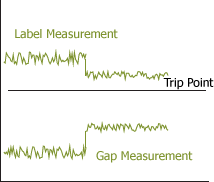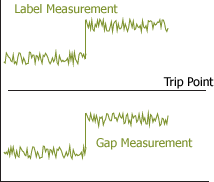Adjusting a label sensor is easier than most people think.
Sensors are often adjusted when it isn’t necessary.
Triggering the Sensor
Optical sensors measure light; capacitive sensors measure electric fields; ultrasonic sensors measure sound waves. No matter what your label sensor measures, the measurement is different for the gap than it is for the label, and the measurement includes some unwanted noise.
The sensor is adjusted so the gap measurement is on one side of a trip point, and the label measurement is on the other side of the trip point – and so the noise won’t accidentally trip the sensor.
These measurements are adjusted to change the difference between the label and the gap and to shift them relative to the trip point.
Changing The Difference
On some sensors, the Gain (or Span, or Sensitivity) can be adjusted to be sure there is enough distance between the label measurement and gap measurement. Turning the gain too high can amplify noise in the sensor and cause a false trigger; so more is not always better.
Shifting the Measurement
The position of the label and gap measurements can be shifted relative to the trip point to get the trip point in the center. This adjustment may be called “Shift” or “Offset” or “Zero.”

Gain/Span adjustments change the distance between the Gap and Label measurements and change the amount of noise in the measurement.

Shift/Offset/Zero adjustments move the Gap and Label measurements up and down relative to the Trip Point.
